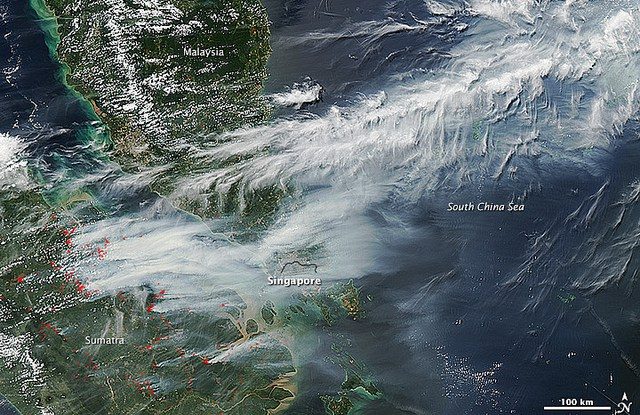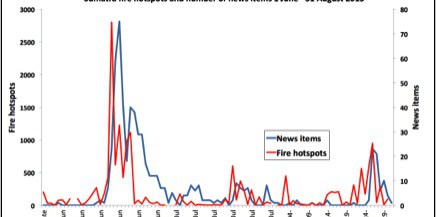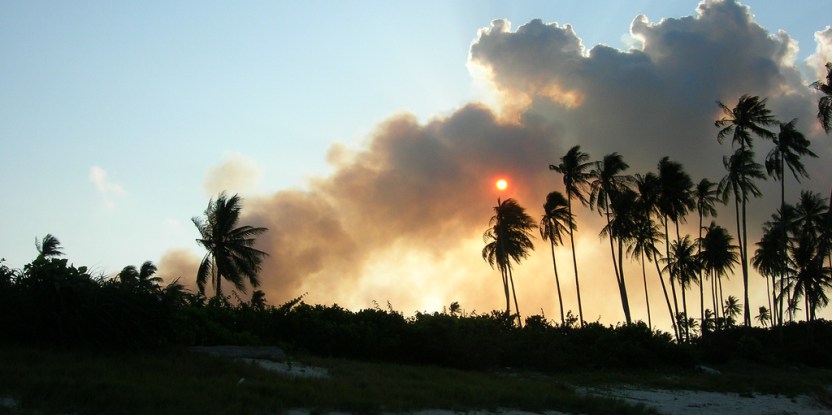
Accurate information on the causes of wildfires and the amount of carbon emissions they produce is critical if Indonesia is to meet its emissions reductions targets, said experts at an event on the sidelines of the U.N. climate change meetings in Warsaw, Poland.
Earlier this year, fires swept across parts of the Indonesian island of Sumatra — sending smoke billowing across the narrow Strait of Malacca and causing record-breaking air pollution levels in Singapore and Malaysia.
Daniel Murdiyarso, a principal scientist with the Center for International Forestry Research (CIFOR), said that the international media attention the event generated must be translated into funding for more detailed research — and a commitment by the Indonesian government to address the issue.
“The haze occurred in the wrong time in the wrong place — and so it got to the attention of media very quickly,” Murdiyarso said. “If it had blown towards the Indian Ocean, the story would have been different.”
When the environment ministers of Malaysia, Singapore, Thailand and Brunei met in July to discuss the fires, they urged Indonesia to do more to tackle them.
DATA DELIVERY
Murdiyarso says this is an opportunity for Indonesia to invest in the technologies that will enable the country to accurately measure “activity data” and “emissions factors” — used to assess greenhouse gas emissions due to the conversion of forest to agricultural land.
“This is a long-overdue process – we need to inform the policy community with really credible data,” Murdiyarso said.
This would give Indonesia more information about the causes and consequences of fires, and enable the government to identify actions that can help it to meet its target of a 26 percent reduction in greenhouse gas emissions by 2020, he said.
“Looking at the magnitude and causes of the carbon emissions from land-use change, this is a low-hanging fruit. On peatlands, one single fire can produce five to six times more carbon emissions than would be produced by clearing the same land area by other means.”
“That means tackling the underlying causes of fire is something the government can do relatively quickly, but have a big impact on emissions and transboundary pollution.”
People tend to think fires are accidental, driven by something biophysical — but often the market drives them
CIFOR research into the fires has indicated that nearly a quarter of the June fires burned in industrial oil palm and acacia plantations, and very few took place in natural forests.
But the research raised more questions than answers.
COMPLEX CAUSES
“The fire this year is very interesting because it did not happen in an El Niño year,” Murdiyarso said, referring to the weather phenomenon that usually causes dry conditions across much of Indonesia.
People typically wait for a long dry spell, Murdiyarso said, to burn off the land. But this year hasn’t been particularly dry. “So there must be something else that drives them to burn — maybe the market is very attractive to quickly plant agricultural crops, to quickly produce the commodity, to meet the demand of the market.”
“People tend to think fires are accidental, driven by something biophysical — but often the market drives them. The socio-economic reality on the ground is much more complex than what we thought.”
While Indonesia’s neighbors did suffer the effects of the haze, the fires had a more severe impact locally — causing respiratory problems in youth and the elderly, and affecting people’s livelihoods, Murdiyarso said.
Local governments also need to be more engaged in tackling the problem, not just by fighting the fires, but also preventing them through proper land-use planning, he said.
“I hope these locally relevant issues can be nicely linked to the global initiatives, so that the activities on the ground, at the local or national level, match with the global interest to reduce greenhouse gas emissions,” Murdiyarso said.
Farhan Helmy, secretary of the Mitigation Working Group at Indonesia’s National Council on Climate Change (DNPI), said the Indonesian government is taking the fires seriously.
Since July, Helmy said, DNPI has been working on a comprehensive report about the drivers and greenhouse gas emissions from the fires. The report will be released in the coming weeks.
DNPI aims to share the report with Indonesian line ministries and other interested organizations, and open a dialogue between scientists and policy makers on the topic.
“My worry is that we discuss the same thing next year — but without a resolution. And all we do is wait for the rain to come — so we would like to have more comprehensive solutions on this,” Helmy said.
“We have to stop what is happening now — enough is enough.”
For more information about the issues discussed in this article, contact Daniel Murdiyarso, d.murdiyarso@cgiar.org.
This work forms part of the CGIAR Research Program on Forests, Trees and Agroforestry.
We want you to share Forests News content, which is licensed under Creative Commons Attribution-NonCommercial-ShareAlike 4.0 International (CC BY-NC-SA 4.0). This means you are free to redistribute our material for non-commercial purposes. All we ask is that you give Forests News appropriate credit and link to the original Forests News content, indicate if changes were made, and distribute your contributions under the same Creative Commons license. You must notify Forests News if you repost, reprint or reuse our materials by contacting forestsnews@cifor-icraf.org.

